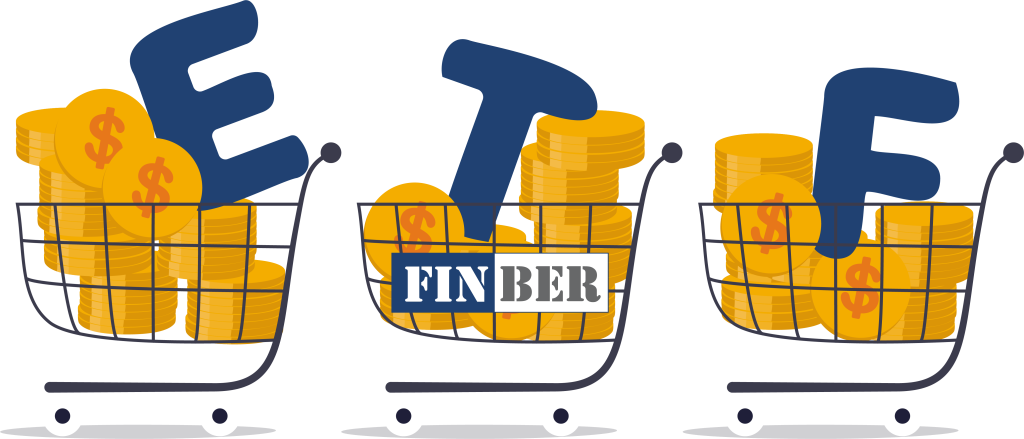
Exchange-Traded Funds (ETFs), or exchange-traded funds, are an important element of the modern investing world. But what are ETFs, and why are they attracting investors' attention? In this article, we'll look at the key aspects of ETFs, explain how they work, and why they have become a popular tool for portfolio diversification and achieving financial goals.
What is an ETF?
ETF – “Exchange Traded Fund”, a fund traded on an exchange. To better understand what an ETF is, imagine the following:
7 investors decided to drop $100 each and buy 10 shares, because it is EXPENSIVE for everyone to buy the same 10 shares. The guys organized a fund by buying these 10 shares with money from the common “pot”, and then equally dividing the parts of the fund among themselves. As a result, each investor became the owner of one share, i.e. 1/7 of each share. This is exactly the principle that an exchange-traded investment fund (ETF) operates on.
It is often said in financial circles that ETFs "democratize" investing. Thanks to them, the stock market has become accessible to private investors who do not have access to large sums for investment.
History of ETF creation
The idea of creating such an innovative exchange product that could reduce market volatility arose back in 1988 and belonged to Nathan Most, vice president of new product development at the American Stock Exchange (AMEX). True, due to bureaucratic delays, the Americans lost in the initial implementation of this idea to the Canadians. These guys turned out to be a little quicker and released the first official ETF in 1990, which repeated the Toronto Stock Exchange 35 Index - the index of the Toronto Stock Exchange.
Only three years later, in 1993, the famous SPY (in our opinion “spider”), the first American ETF for the S&P 500 index (SPDR S&P 500 ETF), saw the light of day. Today, SPY is the most traded exchange-traded fund in the world, with more than $5 billion in assets.
ETF providers
Each exchange-traded fund, or ETF, is managed by a specific company called an “ETF provider.” One provider usually manages several/many funds.
There are no good or bad providers. It’s just that each one has its own characteristics in the form of commissions, region, management method, etc.
- List of the world's largest ETF providers:
- iShares
- Vanguard
- luxor
- SPDR
- Amundi
- Xtrackers
- WisdomTree
Important: If the ETF issuer/provider goes bankrupt, the investor will be able to lay claim to the securities held in the fund's portfolio.
Benefits of ETFs
- ETFs have a number of advantages compared to other investment instruments:
- 1. ETFs help minimize market risks through diversification. Due to the wide range of different stocks/bonds included in the ETF (up to 4.000 shares), the investor’s portfolio will become less volatile and more stable in times of crisis.
- 2. ETFs are a great way to “buy the entire market” with a small investment and without the hassle of choosing individual stocks. An excellent tool for investors with small initial capital. To buy your first ETF fund, 100 euros is enough.
- 3. For people just starting out on the investment path and trying to “test out” the market, ETFs are more likely to bring higher returns than individual shares.
- 4. ETFs are ideal for passive investing. It does not take much time for an investor to maintain an investment portfolio based on ETFs. A couple of hours a year is enough.
How to choose ETFs?
- So, what criteria should you use to select quality ETFs that will form the basis of a balanced and sustainable portfolio? I announce the entire list:
- 1. The value of “Total Expense Ratio” (English), abbreviated “TER”, German. “Verwaltungsgebühren” is the fund management fee, expressed as a percentage of the value of the fund’s assets. For example, by investing €1000 in ETF X, which has a TER of 0,2%, you will pay the provider of this ETF as much as €2 per year. “Just a penny,” you say. But this is just an example. In practice, there are funds that retain more than 10%. TER is automatically deducted from the cost of the ETF and in practice this commission is “not visible”. But the smaller it is, the better, and the more effectively the ETF will reflect the dynamics of the index.
- 2. Play big. No dwarf funds. The assets under management of the fund (AuM - English “Assets under management”) must be at least $400 Mio. It is logical to assume that the more people have entrusted their hard-earned money to a fund, the more reliable the fund should be. In addition, large funds tend to have lower fees because they can afford it.
- 3. Date of foundation of the fund. The older the fund is, the more likely it is that it will not be disbanded. We choose the oldest funds possible.
-
4. Select physical replication. The task of an ETF fund is to repeat (replicate) the dynamics of a certain index (or asset). According to the replication method (English “replication method”, German “Replikationsmethode”) ETFs can be divided into two types:
1. Physical replication (within the fund there are directly shares from the index);
2. Synthetic replication (or “SWAP”) (there are no securities included in the index within the fund).
Instead, there are swap contracts between the management company and banks. We select funds with physical replication. They are more transparent. - 5. Composition of the fund. It happens that one company takes up to 20% of the fund. This is too much. We make sure that there is not a large bias towards one (or two) companies in the ETF.
- 6. No leveraged or inverse ETFs.
- 7. “Everything that is ingenious is simple, and everything that is simple is ingenious,” - this phrase simply perfectly reflects the main principle of selecting ETFs. Start with the simplest strategies. Want to still add elements of your personal creativity to your portfolio? Then allocate a specific one for this task (small) (!) part of the portfolio and create for your health.





